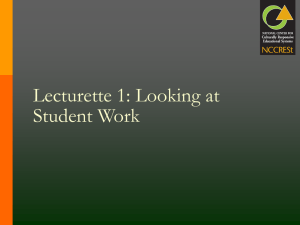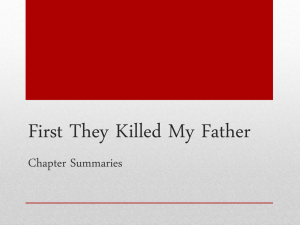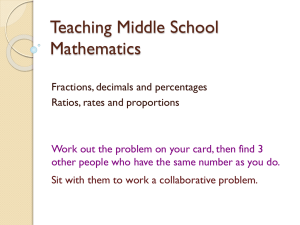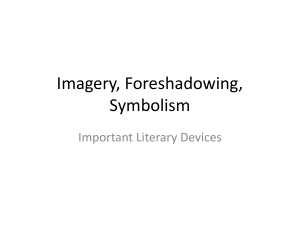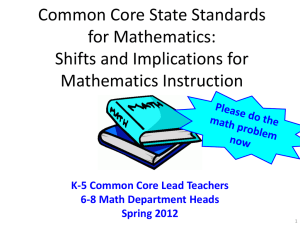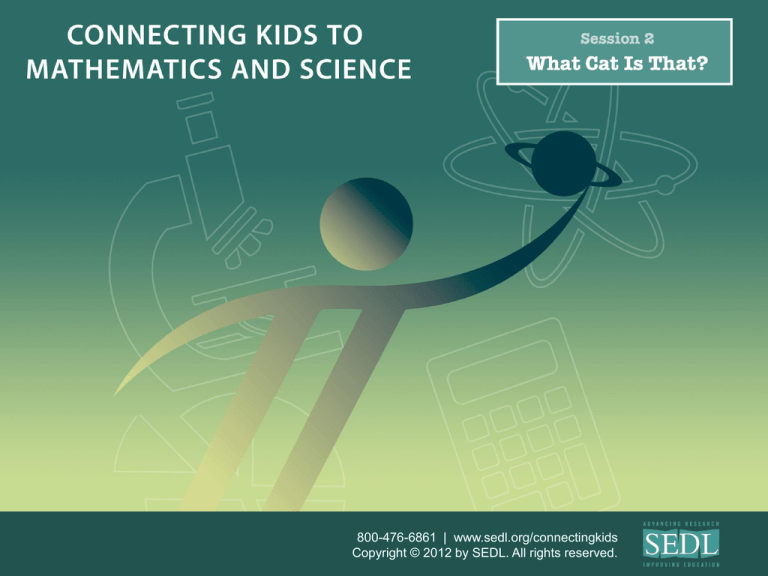
800-476-6861 | www.sedl.org/connectingkids
Copyright © 2012 by SEDL. All rights reserved.
Photo: Thinkstock (istockphoto Collection). SEDL used in compliance with its Thinkstock license agreement.
2
Photo: © Google. SEDL used in compliance with Google Maps/Google Earth Content Rules and Guidelines.
Retrieved January 12, 2012.
3
Photos: left: Thinkstock/Hemera Collection. SEDL used in compliance with its Thinkstock license agreement;
right: © Bone Clones. Retrieved from http://www.boneclones.com/SC-018A.htm. SEDL used with permission.
4
Setting the Stage
Solve the prehistoric cat problem
provided on a separate handout.
Discuss your solution approach or
strategies with others at your table.
Share with the whole group.
5
Setting the Stage
Examine the handout with the sample
solution strategy.
With one or more partners, list the
prerequisite knowledge needed to solve a
problem such as the one just attempted.
6
Setting the Stage
Go to the TEA TEKS Web
page:http://ritter.tea.state.tx.us/rules/tac/chapter
111/index.html
Identify and list the K–8 mathematics objectives
that address the ideas of ratio and proportion.
Findings? Patterns?
7
Setting the Stage
Materials: Cutouts with possible prerequisites
for developing proportional reasoning
With a partner or group, sort the cutouts
into a logical framework based on criteria of
your choosing.
Whole group share/report
8
Setting the Stage
Examine prerequisite knowledge through
“knowledge packages.”
Break down the prerequisites.
9
Mathematical Proficiency
According to the National Resource Council,
students are expected to attain “mathematical
proficiency.”
Mathematical proficiency is composed of five
interwoven competencies.
Kilpatrick, J., Swafford, J., & Findell, B. (Eds.). (2001).
Adding it up: Helping children learn mathematics.
Washington, DC: National Academy Press.
10
Mathematical Proficiency
1. Conceptual understanding—comprehension
of concepts, operations, and relations
2. Procedural fluency—carrying out procedures
flexibly, accurately, efficiently, and
appropriately
3. Strategic competence—ability to formulate,
represent, and solve problems
11
Mathematical Proficiency
4. Adaptive reasoning—capacity for logical
thought, reflection, explanation, and
justification
5. Productive disposition—habitual inclination
to see mathematics as sensible, useful, and
worthwhile, coupled with a belief in
diligence and one’s own capacity
12
Conceptual Understanding
It may not be an accident that conceptual
understanding is the first component listed.
Conceptual understanding is the foundation on
which the other four components are grounded.
13
Conceptual Understanding
• Conceptual understanding goes far beyond
“how to.”
• With conceptual understanding, students know
– what a concept really is,
– why it works,
– how it connects to other concepts, and
– what it looks like symbolically and graphically.
14
Conceptual Understanding
• The focus is always on a deep understanding
of CONCEPTS.
• Field of Dreams—If you build it, they will come.
– Math Corollary I (for students)—If you build
the concepts, the skills will follow.
– Math Corollary II (for teachers)—If you build
your content knowledge, the activities/lessons
will come.
15
Conceptual Understanding
Conceptual understanding enables us to
1. view an idea or concept from multiple
perspectives;
2. make critical connections to other
fundamental concepts and ideas; and
3. recognize and understand subtleties in
language, symbolism, and representation.
16
Conceptual Understanding and Language
• Conceptual understanding enables teachers and
students to recognize and understand subtleties
in language, symbolism, and representation.
• The foundation for the understanding of
mathematics is based on deep, fundamental,
and conceptual definitions of critical concepts.
• Deep conceptual understanding in turn is
connected to the types of questions teachers
use as part of classroom instruction.
17
Classroom Application
What can we do to teach MATHEMATICS
(not arithmetic and efficiency) to ALL students?
• To the extent possible, use concrete
examples or manipulatives.
• Emphasize both symbolism and academic
language.
• Organize thinking with graphic organizers.
• Use ambiguity to your advantage, not as a
disadvantage.
18
Classroom Application
What can we do to teach MATHEMATICS
(not arithmetic and efficiency) to ALL students?
• Simplify, yet deepen.
• Use the deep knowledge of one topic to
make connections to and leverage the
learning of related topics.
• Teach mathematics as relationships.
19
Classroom Application
These strategies do not occur in isolation.
Several can be used simultaneously, making
each activity or strategy even more powerful.
20
Fractions—Beyond Slices of a Pizza
Students must see the big picture of fractions.
What does ¾ mean? In small groups, develop
a tree diagram that illustrates the possibilities
and be prepared to share with the whole
group.
21
Fractions—Beyond Slices of a Pizza
How can we begin to instill the idea of a
fraction as a ratio (rather than the traditional
“parts of a whole”) in earlier grades?
Use the provided materials to model one
approach.
22
Fractions—Symbolism and Language
1 2
=
2 4
Is the above true or false? Justify.
23
Fractions—Symbolism and Language
Why 1/2 = 2/4 is false.
24
Fractions—Symbolism and Language
Why 1/2 = 2/4 is false.
25
Fractions—Symbolism and Language
• Solve mentally:
10
½
• For the above, you got an answer. What was the
question that you answered? Explain.*
*Do not use any form of the terms divide or goes into.
26
Fractions—Symbolism and Language
Students’ Interpretations of Symbols
1. Do students see ⁵⁄₄ as 5 x ¼?
Do students see ⁵⁄₄ as 5 one-fourths?
Why or why not?
2. Do students see 1½ as 1 + ½?
Do students see that 9 = 1½ x 6 means that 9 is 1
and ½ sixes (1 six and half of another six)?
27
Fractions—Symbolism and Language
How can this division problem be interpreted
as a proportion?
4 5
28
Fractions—Symbolism and Language
Trace how the “whole” changes in this scenario:
Stevie has ½ gallon of gasoline in his container.
He uses ⅔ of the gasoline to mow the grass.
How much gasoline did he use?
29
Fractions—Symbolism and Language
A map indicates the following scale:
1 inch = 20 miles
Would that confuse you?
Consider:
1 inch
20 miles
(on map)
(real life)
30
Early Foundations of Proportionality
1. Define multiplication.
2. How are multiplication and division
the same?
3. How can a conceptual understanding of
multiplication be used as a powerful tool to
establish an early foundation for students’
understanding of inverse variation?
31
Early Foundations of Proportionality
Show me what “5 more” looks like.
(Hint: Use vertical bar graphs.)
32
Early Foundations of Proportionality
Show me what “5 more” looks like.
20
6
15
1
10,005
10,000
33
Early Foundations of Proportionality
Show me what “half as much” looks like.
(Hint: Use vertical bar graphs.)
34
Early Foundations of Proportionality
Show me what “half as much” looks like.
40
2
1
20
5,000
2,500
35
Early Foundations of Proportionality
Solve:
In the same 6-week period, one pig grew from
5 pounds to 10 pounds. Another pig grew from
100 to 108 pounds. Which pig grew more?
36
Early Foundations of Proportionality
Suggested strategy:
Ask students for definitions and give them
three options.**
1. Use a formal definition.
2. Use your own words.
3. Use a drawing, picture, or example.
**Students answer using only one of the three methods.
37
Early Foundations of Proportionality
Define .
1. Formal definition
2. Own words
3. Drawing, picture, or example
38
Prehistoric Cat: What We Know
• Cat-like animal femur bone
• Length of femur bone – 10 inches
• Length of modern domestic cat femur –
about 3 inches
• Weight of a modern domestic cat –
approximately 10 lbs.
• Approximate age of bone – 10,000 to 12,000
years
39
Photo: © Bone Clones.
Retrieved from http://www.
boneclones.com/SC-018A.htm.
SEDL used with permission.
40
How Big Is It?
•
•
•
•
Assume similar musculature.
Domestic cat weighs about 10 lbs.
Fossil femur is 10 inches long.
Modern cat femur is 3 inches long.
What might the prehistoric cat have weighed?
41
Ancient Cat Is Extinct—Why?
Requirements for Survival
• Dietary
• Capacity
• Density
Environmental Factors
42
Ancient Cat Is Extinct—Why?
•http://nationalzoo.si.edu/Animals/GreatCats/catfacts.cfm
•http://www.talktothevet.com/ARTICLES/CATS/feedadultcat.HTM
•http://www.bbc.co.uk/nature/wildfacts/factfiles/3007.shtml
•http://en.wikipedia.org/wiki/Smilodon
•http://www.enchantedlearning.com/subjects/mammals/smilodon/
43
Forced Perspective
An optical illusion that makes things seem
bigger or smaller than they actually are
• Who?
• What?
• Where?
• Why?
• How?
44
Photo: © SEDL
45
Photo: Vin7474, Picture of the Leaning Tower.
Retrieved from http://en.wikipedia.org/wiki/
File:Europe_2007_Disk_1_340.jpg. SEDL used in
compliance with Creative Commons public
domain designation.
46
Photo: © SEDL
47
Photo: © SEDL
48
Photo: Robert Slawinski, StinkyJournalism, Monster pig hoax.
SEDL used with permission from iMediaEthics.
49
Forced Perspective Tips
•
•
•
•
•
•
•
Use the landscape option.
Choose a sunny day; more light is good.
Use the widest angle to exaggerate perspective.
Position the subject in the approximate pose.
Move the camera until you get the shot you want.
Use low angles to exaggerate height.
Take lots of shots.
50

